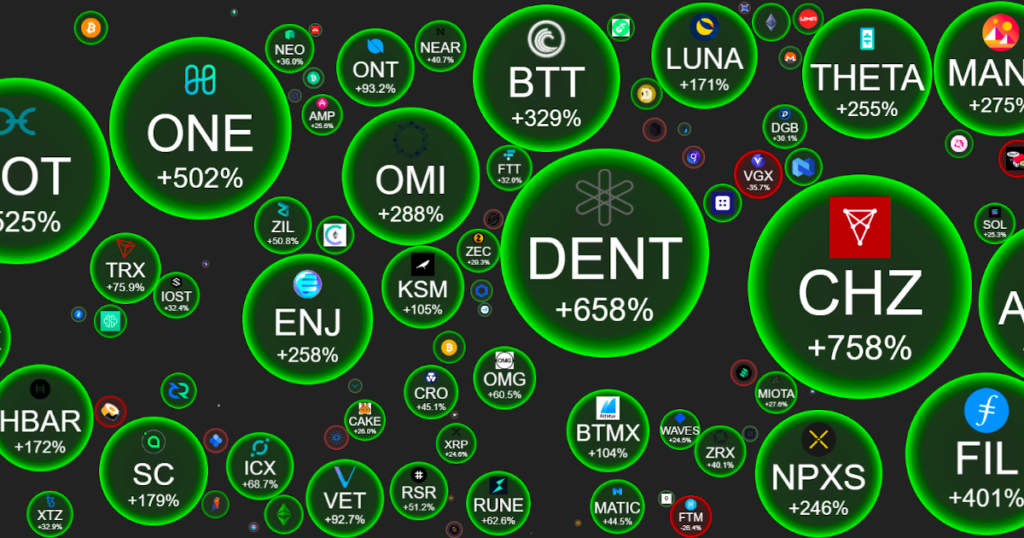Crypto Bubbles refer to periods when the price of cryptocurrency assets dramatically inflates due to excessive speculation, often driven by hype and unrealistic expectations. These bubbles are characterized by rapid increases in value followed by sharp declines once the market corrects itself. They reflect an overvaluation of assets beyond their intrinsic worth, leading to significant financial losses for investors when the bubble bursts. Crypto bubbles highlight the volatile nature of digital currencies and the risks involved in speculative trading.
Imagine waking up to find that your cryptocurrency investment has surged in value overnight, only to crash spectacularly just as quickly. This exhilarating yet nerve-wracking rollercoaster is the hallmark of crypto bubbles.
As the excitement of soaring prices grips the market, many rush in with hopes of quick gains, often ignoring the warning signs of an impending burst. Understanding crypto bubbles is crucial for anyone navigating the volatile world of digital currencies, as it sheds light on the high-stakes gamble of chasing fleeting trends and the importance of cautious investment strategies.
The Origin of a Crypto Bubble: Key Points

Excessive Speculation:
Crypto bubbles often begin with rampant speculation. Investors, driven by the fear of missing out (FOMO), start buying into a cryptocurrency based on predictions of massive returns, inflating its price beyond its actual value.
Media Hype and Publicity:
Media coverage and sensational news play a significant role in the creation of a crypto bubble. Positive headlines and stories of rapid gains attract a wider audience, leading to increased demand and further price hikes.
Influencer Endorsements:
Prominent figures and influencers endorsing a cryptocurrency can drive massive interest and investment. Their support can create a bandwagon effect, where more investors jump in, fueling the bubble.
Technological Hype:
New technological advancements or innovations related to a cryptocurrency can spark excitement and attract speculative investment. For example, announcements of potential upgrades or partnerships can temporarily boost the asset’s value.
Market Manipulation:
Sometimes, market manipulation tactics, such as “pump and dump” schemes, can artificially inflate a cryptocurrency’s price. Early investors may manipulate the market to create an illusion of rapid growth, enticing more investors before selling off their holdings for a profit.
Lack of Regulation:
The relatively unregulated nature of the cryptocurrency market allows for more speculative behavior and misinformation. The absence of stringent regulatory oversight can lead to inflated valuations and eventual crashes, as there are fewer safeguards against manipulative practices.
Key Reasons Causing a Crypto Bubble

One major driver of a crypto bubble is excessive speculation. Investors often pour money into cryptocurrencies based on optimistic forecasts and fear of missing out. This speculative behavior leads to rapid price increases that are not supported by the underlying value or utility of the asset, creating an unsustainable rise in value.
Media hype and publicity also play a crucial role. When news outlets and social media platforms extensively cover a cryptocurrency, especially with sensational or exaggerated claims, it attracts more investors looking to capitalize on the perceived opportunity. This influx of new money can further inflate the asset’s price, contributing to the bubble.
Influencer endorsements can significantly impact the formation of a crypto bubble. When well-known figures or celebrities endorse a cryptocurrency, their followers may be swayed to invest, often without fully understanding the risks. This endorsement can drive a surge in demand, leading to a dramatic rise in prices.
Technological hype surrounding a cryptocurrency can also fuel a bubble. Announcements about innovative technology or promising updates can spark excitement and speculation among investors. The anticipation of future improvements or partnerships can temporarily boost the asset’s value, leading to inflated expectations.
Market manipulation is another factor contributing to crypto bubbles. Certain actors may engage in manipulative practices, such as artificially driving up prices through coordinated buying or spreading misinformation. These actions can mislead investors and create an illusion of growth, leading to unsustainable price levels that eventually collapse.
Finally, the lack of regulation in the cryptocurrency market exacerbates the problem. With limited oversight, there are fewer checks against speculative behavior and fraudulent activities. This regulatory gap allows bubbles to form more easily and can result in more significant crashes when the market corrects itself.
How Do Crypto Bubbles Work?
- Hype
Crypto bubbles often start with a surge of hype. This excitement is fueled by sensational media coverage, influential endorsements, and buzz within the crypto community. As positive news and projections spread, more investors are drawn in, leading to a rapid increase in demand and, consequently, the price of the cryptocurrency. The initial hype creates an environment where unrealistic expectations become the norm, and the asset’s value rises far beyond its intrinsic worth. - Panic
As the bubble inflates, the inevitable question arises: how long can this surge last? Once the hype begins to wane or external factors challenge the asset’s value, panic can set in. Investors, driven by fear of losing their gains or the possibility of a market downturn, start to worry about the sustainability of the inflated prices. This sense of urgency and fear can spread quickly, causing a shift in sentiment and escalating the likelihood of a market correction.
Sell-Off
The culmination of a crypto bubble typically involves a massive sell-off. As panic spreads, investors rush to liquidate their holdings to avoid further losses. This sudden flood of sell orders overwhelms the market, leading to a sharp decline in the cryptocurrency’s price. The sell-off exacerbates the bubble’s burst, as the collapsing value forces more investors to sell, resulting in a downward spiral. The aftermath reveals the true value of the cryptocurrency, often leaving many investors with significant losses.
Can Investors Profit From Crypto Bubbles?

- Timing and Market Knowledge
Investors who manage to time their entry and exit points perfectly can potentially profit from crypto bubbles. By entering early during the hype phase and exiting before the bubble bursts, savvy investors can capitalize on the inflated prices. However, this requires a deep understanding of market trends and a keen sense of timing, which can be challenging due to the unpredictable nature of crypto markets. - Risk and Reward
While the potential for high returns exists, so does the risk of substantial losses. Investing in a bubble can be highly lucrative if done correctly, but it also comes with significant risk. The volatility and unpredictability of crypto bubbles mean that the chance of a dramatic downturn is high, and many investors end up facing losses rather than gains if they are caught on the wrong side of the bubble’s burst. - Speculative Strategies
Some investors employ speculative strategies, such as short selling or using leveraged positions, to profit from the price swings of a bubble. These strategies can amplify potential gains but also increase the risk of severe losses. Successful execution of these tactics requires sophisticated knowledge and experience in market speculation and is not suitable for all investors. - Long-Term Considerations
“Profiting from crypto bubbles can also depend on long-term strategies. Investors who can hold onto their assets beyond the bubble burst and have faith in the underlying technology or project may see value in the long term. For those looking to explore more about emerging technologies and their impacts, check out 127.0.0.1:49342 The Localhost. However, this approach requires patience and resilience, as the initial bubble may cause substantial volatility and market skepticism.”
Is There a Crypto Bubbles App for PC?
- Monitoring Tools and Platforms
While there isn’t a dedicated app specifically called “Crypto Bubbles,” there are various monitoring tools and platforms available for PC that help investors track cryptocurrency prices and market trends. These platforms often provide real-time data, charts, and analysis features that can help users identify potential bubbles and make informed decisions. - Market Analysis Software
Advanced market analysis software can assist in detecting crypto bubbles by analyzing market patterns and trends. These tools may offer features like technical analysis, predictive modeling, and alerts for unusual price movements, which can be useful for investors looking to spot and act on bubble-like conditions. - News Aggregators and Alerts
Crypto news aggregators and alert services available for PC can provide timely information and updates about cryptocurrency developments. Staying informed about news and market sentiment through these platforms can help users recognize the signs of a bubble and adjust their investment strategies accordingly. - Investment Platforms
Some investment platforms and exchanges offer comprehensive tools and dashboards that can help users track their crypto assets and monitor market conditions. These platforms may include features for analyzing price trends, setting alerts, and managing investments, which can be beneficial for understanding and navigating crypto bubbles.
How Do Crypto Bubbles Differ from Traditional Financial Bubbles?

Market Structure and Regulation
Crypto bubbles occur in a relatively unregulated market, which contrasts with traditional financial bubbles typically found in more regulated environments. The lack of regulation in the cryptocurrency space allows for greater volatility and speculative behavior, whereas traditional financial markets have more oversight and regulatory measures designed to mitigate extreme fluctuations.
Speed of Price Movements
The price movements in crypto bubbles are often much faster compared to traditional financial bubbles. Cryptocurrencies can experience rapid spikes and crashes within days or even hours due to the 24/7 nature of the crypto market and the influence of social media and online forums. In contrast, traditional financial bubbles usually develop and burst over a longer period, such as months or years.
Market Participation
Crypto bubbles attract a diverse range of participants, including retail investors and speculators who may not have extensive financial expertise. This broad participation is driven by the ease of access and the potential for high returns. Traditional financial bubbles often involve institutional investors and experienced market participants, which can lead to different dynamics in bubble formation and burst.
Technological Influence
Cryptocurrencies are heavily influenced by technological advancements and innovations, which can drive speculative interest and contribute to bubble formation. For example, new technology or blockchain projects can generate hype and inflate prices. Traditional financial bubbles, on the other hand, are less influenced by technology and more by economic factors, market sentiment, and financial instruments.
Volatility and Risk
The volatility in crypto markets is typically higher than in traditional financial markets. Crypto bubbles can lead to extreme price fluctuations, making them riskier for investors. Traditional financial bubbles may also involve significant volatility, but the price swings are generally less dramatic due to the more stable nature of established financial instruments and markets.
Investor Behavior and Sentiment
Investor behavior in crypto bubbles is often characterized by intense speculative enthusiasm and herd mentality, driven by social media and online communities. This behavior can lead to rapid price increases and equally rapid declines. In traditional financial bubbles, investor behavior might be influenced more by traditional economic indicators, financial reports, and professional advice, though herd behavior and speculative trends are still present.
Tools and Tips for Smart Investing
Utilizing advanced investment tools can significantly enhance decision-making and risk management. Platforms offering real-time data, charting software, and market analysis can provide valuable insights into market trends and asset performance. Tools like financial calculators, portfolio trackers, and risk assessment models help investors make informed choices and adapt strategies based on current market conditions.
In addition to using the right tools, developing a sound investment strategy is crucial. Diversifying investments across various asset classes can reduce risk and increase potential returns. Setting clear financial goals, conducting thorough research, and staying informed about market developments are essential practices for successful investing. Regularly reviewing and adjusting your investment strategy in response to changing market conditions will help you stay on track and achieve your financial objectives.
Conclusion
In the volatile world of cryptocurrencies, understanding the nature of crypto bubbles is crucial for any investor. As we’ve seen, these bubbles are driven by speculative hype, rapid price movements, and a lack of regulation, making them inherently risky. Recognizing the signs of an inflating bubble and the subsequent sell-off can help investors navigate the highs and lows of the crypto market more effectively.
Ultimately, while crypto bubbles present opportunities for high returns, they also come with significant risks. Investors should approach these opportunities with caution, ensuring they have a well-informed strategy and the ability to adapt to sudden market changes. By staying informed and applying prudent investment principles, individuals can better manage their investments and avoid the pitfalls associated with the speculative nature of crypto bubbles.

